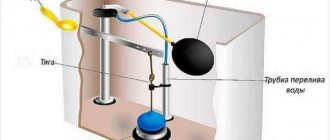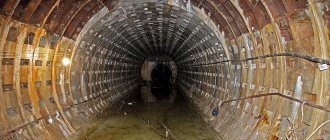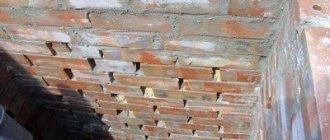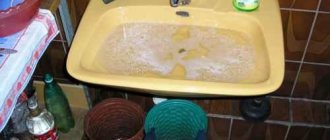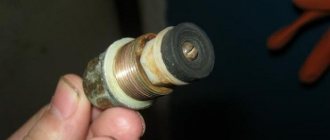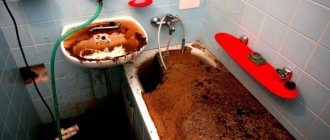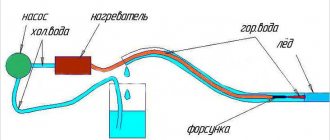If the water in the toilet does not drain well, what should you do? This problem needs to be dealt with as soon as possible, as it can quickly develop into a complete blockage of wastewater outflow. Any plumbing fixtures tend to become clogged if they are not cleaned regularly. Proper maintenance of the toilet allows you to prevent such a problem from occurring, but if there is already a problem with the outflow, it is necessary to use the optimal methods for removing the existing blockage for a particular case.
Among other things, it should be borne in mind that water can not only drain slowly from the toilet: under certain conditions, the water level can rise. As a rule, such an unfavorable development of events is observed if the riser pipe in the area in front of the place where the toilet is connected to it is clogged. Thus, when flushing water from the upper floors at the bottom of the pipe, the pressure at the site of the blockage can increase significantly, which helps push some of the water into the closest toilet. In such an unfavorable scenario, only a qualified plumber can solve the problem.
Improper installation of sewerage
The next reason is improper laying of sewer pipes, incorrect slope. The diameter of the sewer pipe is incorrectly selected. The diameter of the sewer pipe should be approximately 100 mm (10cm). It happens that construction debris, sand, or mortar gets into the pipe, as a result, the passage of the pipe is reduced and then the ingress of hair, cotton wool or wood litter for cat litter firmly clogs the toilet.
The quality and defects of the toilet itself, you purchased a non-certified product, for example, in China, with a small drain neck with a mousehole diameter of 50 mm.
Installation of sewer pipes is carried out at a slope within strictly defined limits.
If the slope is small, the liquid simply will not flow down them, and if the slope is too large, the water will drain quickly, but the contamination will remain in the pipe.
Paradoxically, excessive “leaking” of the sewer pipe leads to chronic blockages. SNiP give the following values for MINIMUM slopes of sewer pipes:
With diameter
- 50 mm – 30 mm/m.
- 110 mm – 20 mm/m.
- 160 mm – 8 mm/m.
- 200 mm – 7 mm/m.
The MAXIMUM slope should not exceed 150 mm/m, with the exception of bends for plumbing fixtures up to 1.5 m long. Connecting sewer pipes at right angles is allowed only in a vertical plane.
Mechanical cleaning
A plunger and a plumbing cable will help you remove a blockage in a toilet or bathtub mechanically. The first increases the pressure in the pipes, which causes the mud plug to first rise and then go into the sewer. And the second one is screwed into the blockage and destroys it through rotation.
Scheme for using a plunger:
- Fill the bathtub or toilet with water.
- Fix the rubber part of the plunger onto the drain hole of the device.
- Press firmly on the handle of the plunger several times and sharply remove the device - repeat these steps until stagnant water with raised contaminants begins to flow into the pipes.
The easiest way to clean it is with a plunger.
Technology for cleaning sewers with a cable:
- Run the cable into the drain hole and push it deep until it hits the dirt plug.
- Begin to actively rotate the cable around its axis and forward/backward to destroy the blockage as much as possible.
- Periodically lift the cable to clear it of dirt and check water drainage.
Sewer system malfunction
A malfunction of the sewer system, for example, if you live on the ground floor, when the sewer pipe is combined with a storm drain line. All it takes is a good rainfall and your sewer system will work intermittently.
It’s winter outside, and due to an incorrectly adjusted shut-off valve in the tank, the water does not close, but constantly flows into the sewer in a thin stream and freezes in severe frost. If the sewer pipe is not dug in at the proper depth, a blockage is guaranteed. The sewer does not clog, but freezes.
In this case, you need to contact the housing office or the management company for servicing the local area. You most likely won’t be able to fix this on your own; you need a professional plumber.
If the riser is thoroughly clogged and the plumbers cannot clear the blockage, you will be prepared to have to disassemble the plumbing, remove the casing, for example, when installing a wall-hung toilet, disassemble the toilet itself, remove the drain pipe and corrugation. Prepare for unpleasant odors and the sight of sewage and feces on the floor. It's better not to see this for the faint of heart.
For the future, we recommend installing a non-return valve in the sewer pipe. The valve costs an average of $150-200, but you can choose cheaper models. If there is no free space to install a check valve, you can use sewer check valves with internal installation.
This check valve allows you to swallow the entire contents of the toilet, but will not allow you to “vomit” anything back.
The check valve concerns exclusively the first floors of an apartment building.
If residents of the upper floors very willingly flush feminine hygiene products and rolls of toilet paper down their toilets, then in the basement this lounger can very easily become clogged and water will begin to rise up the pipe in a column.
But it will only go up to the first toilet, i.e. to the first floor. And then from the toilet on the first floor it will flow onto the floor. Those. Simply put, everything that people wash off from the upper floors, at a certain moment they will begin to wash it all off onto the floor of the first floor apartment. And if you encounter a similar situation, then a device such as a check valve can be a salvation.
Bleeding air in radiators
So, first of all, you should focus on bleeding air from heating devices - radiators. In this case, you should use the already proven option: bleed the air through the Mayevsky valve. This tap is usually installed instead of blind plugs on the radiator, at the highest point. This arrangement implies the accumulation of excess air directly under the valve. In other words, when it opens, the first thing that will come out is air, and then water will come out, which will indicate that the plug in the heating system has been completely eliminated.
To do this, you just need to place a container into which a small amount of liquid will be poured out along with the air. Open the tap and wait until only water comes out, without the characteristic sounds of air bubbles.
Problems with the tank
Problems with the tank most often arise for three reasons: due to improper installation; after incorrect setting of the fittings; as a result of wear or breakdown of individual components and elements. If there is too much or not enough water in the tank, first of all, it is recommended to check the condition of the float.
If it is held by a thick wire lever, adjustment will be easy. It is enough to slightly bend the metal so that the float changes its position. If more water is needed, the float must be moved higher. To do this, the wire is bent in an arc downwards.
Video: Adjusting the toilet tank
Reasons for the formation of air jams
The finished closed-type heating system is sealed, but this does not guarantee the absence of air bubbles. Where does the gas in pipes and radiators come from?
Air appears in the heating system for the following reasons:
:
- The coolant is tap water that has not undergone special preparation - when heated, air dissolved in the water begins to release, and plugs form from small bubbles.
- The tightness of the system is broken, and air is gradually sucked in through loose connections.
- During the repair work, part of the circuit was disconnected by shut-off valves, some elements were replaced or cleaned, and then the coolant was again supplied to the repaired circuit.
- The pipeline was laid in violation of standards - the small angle of inclination of the pipes and improper installation of kinks prevent gas bubbles from entering special devices - air vents. As a result, gas accumulates in problem areas and interferes with the normal circulation of the coolant.
- If the heating system of a private home fills up very quickly (or when the coolant supply is not at the lowest point), the liquid is not able to completely displace air from complexly configured places in the pipeline and radiators.
- Air vents are missing or incorrectly positioned. Also, the reason for the incorrect operation of the air bleed device is its contamination by mechanical inclusions in the unfiltered coolant.
Separately, it is worth considering gas formation in aluminum radiators. When metal comes into contact with a slightly alkaline coolant, hydrogen is released, which accumulates at the highest point of the heating device. If the radiator is not equipped with an air vent, over time the gas lock will not allow the coolant to pass freely through the internal channels of the heating device.
Drain channels are clogged
The tank is filled with ordinary water, which contains mineral salts. Over time, they are deposited on the surface of the tank walls and working elements. Such growths are called hardness salts or lime deposits. Based on the fact that the drain holes are relatively small in size, lime deposits clog them, leaving a small gap for water to pass through.
In order to get rid of this problem, leave approximately 1 liter of water in the tank, but no more, and carry out chemical cleaning using one of the recipes:
- Pour 100 g of 5-7% phosphoric acid solution into the tank, and after 10-15 minutes rinse with water.
- Add 0.5 liters of borax and vinegar to the water in the tank. After 2 hours, rinse with water.
- Add 3-4 bags of ordinary citric acid to a tank of water, and rinse off after a couple of hours.
It is convenient to carry out this procedure late in the evening, leaving the acid inside the tank for the whole night.
More on the topic: How to clean a toilet tank from rust and plaque
As a preventative measure, you can install a coarse filter at the outlet, which is also the input.
If for some reason this cannot be done, then there is another way - tablets for the tank. Their effect is based on softening water and cleaning the entire drainage system. These tablets are produced by different manufacturers, but they are all quite effective.
More on the topic: How to make tablets (bombs) for the toilet yourself
Damage to the enamel inside the toilet bowl
If the enamel surface inside the plumbing bowl is rough, or scratched, or there are cracks or chips, all this may be the cause of poor flushing of the toilet . In such cases, experts recommend thinking about buying new plumbing fixtures. But if for some reason you are unable to purchase a new toilet, you can repair the old one.
For this you will need:
- special putty (can be replaced with waterproof sealant), which is suitable for ceramic surfaces;
- powder paint;
- spray gun.
Once you have purchased the necessary material and tools, you can begin repairing plumbing equipment. To do this you need to do the following.
First, you need to clean and degrease the surface of the toilet bowl (from the inside). Secondly, places where there are cracks and chips should be cleaned with sandpaper (preferably fine-grained).
After this, all problem areas must be covered with putty or sealant. Wait for the putty to dry well before painting the surface.
It is not recommended to use plumbing equipment for three days (the paint must be completely dry).
Even if you have restored old plumbing, you still need to think about buying a new toilet. Because painting a ceramic surface at home cannot be compared with factory enameling. In addition, such a coating will not last long, and the toilet will again begin to flush poorly.
Problems with the fan riser
In short, the sewer drain riser is nothing more than ventilation.
Its main task is to ensure air flow inside the sewer system, which ensures its ability to quickly cope with the transportation of large volumes of water and remove unpleasant odors.
Let's be honest - the relevant housing office services have a negative attitude towards the issue of removing this part of the riser, even if it is being replaced with an air valve. Why?
Everything is simple here - its absence entails a lot of problems that begin to fall one after another on their heads. And although these troubles can be counted on one hand, they can make life unbearable for residents of a high-rise building. Such problems include the following.
- foul odor
- problems with the sewer system
In addition to draining the water seals, the absence of a drain pipe certainly affects the operation of the sewer system - as a rule, it begins to clog more often. The lack of the same full air flow does not allow the system to quickly and effectively remove human waste. This nuance is especially true for sun loungers - if before you had no trouble with them, now you will have to clean them with enviable regularity.
Now decide for yourself whether you need a fan riser in your apartment or maybe it’s better to put up with its presence? By the way, if you are a resident of a private house, then you should not think that you will not have such problems. It should be understood that no matter the size of the sewerage system and no matter how correctly it is assembled, the drain riser is its integral part, and its full replacement simply does not exist.
Video material
Owners of apartments and private houses who have already encountered the problem of a clogged toilet are more attentive to the rules for operating this plumbing. The recommendations from this article will help you eliminate the trouble associated with the bathroom, and by taking precautions, you will not encounter it in the future.





